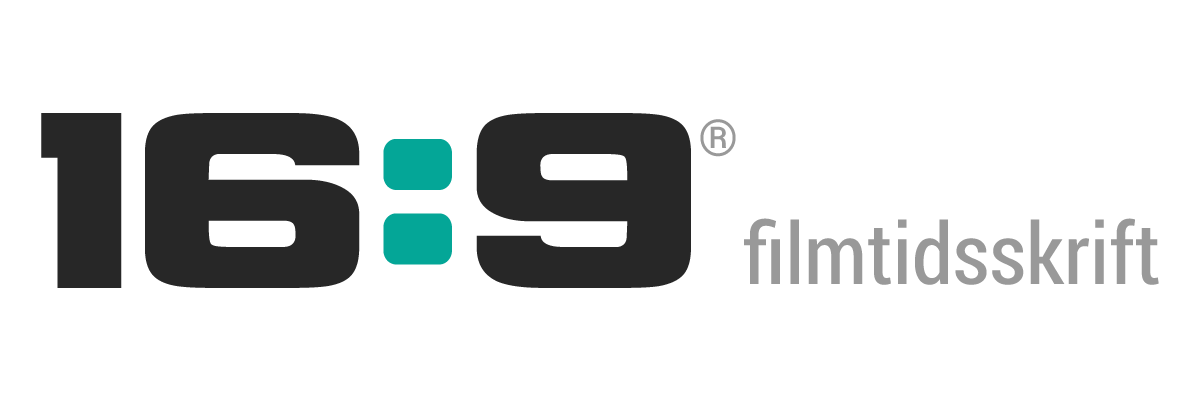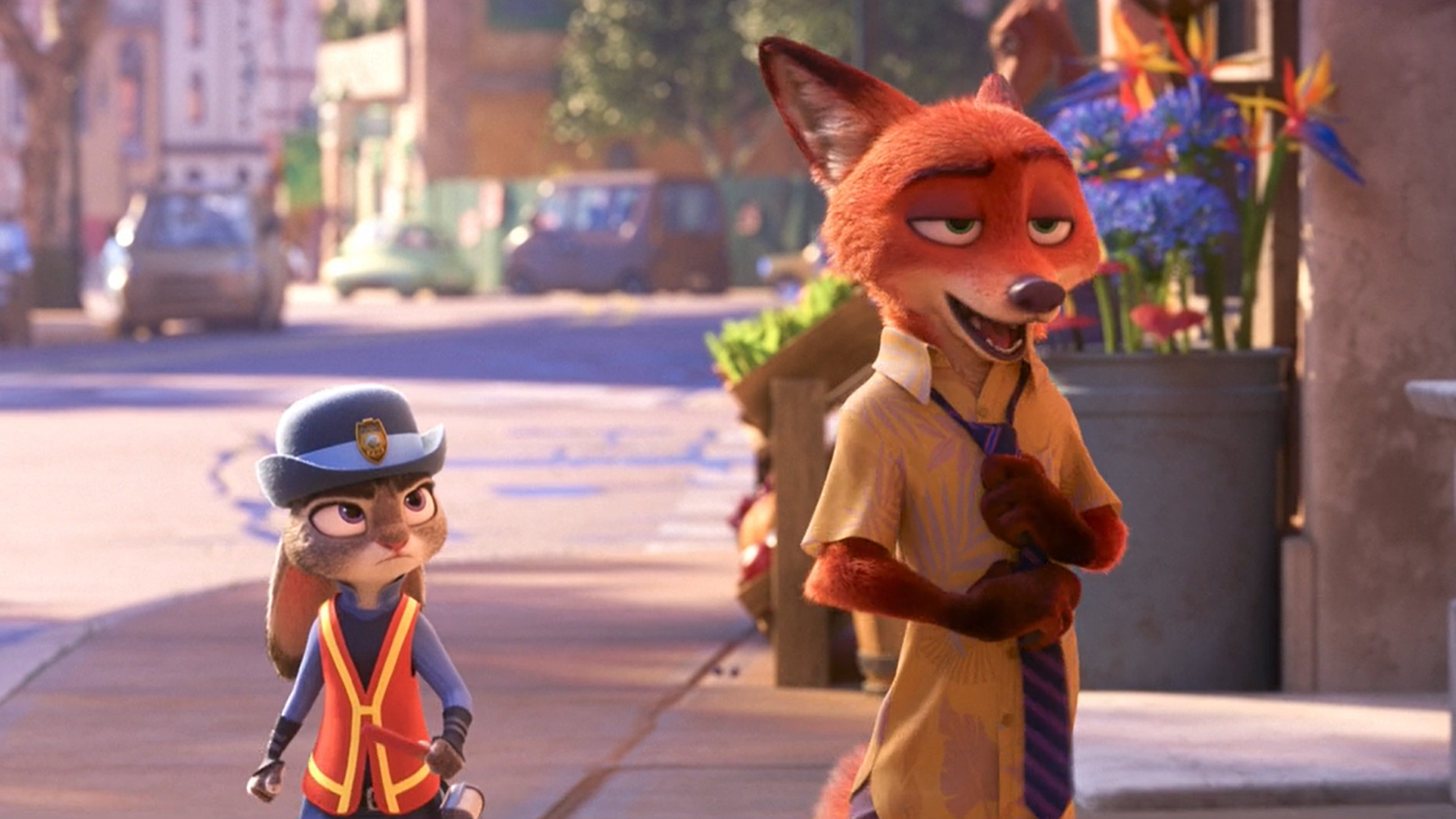The Danish dubbings of Disney’s animated films are typically faithful to the originals and accomplished in their own right. There is, however, one aspect of the original English voice performances that they rarely capture, which is their creative use of different accents and dialects. This article examines how the resulting lack of linguistic diversity can compromise not just a film’s characterization, but also its narrative cogency and thematic impact.
The animated world of Disney’s Zootopia (Howard and Moore 2016) teems with anthropomorphized animals that speak with each other in different varieties of English. One of these animals is Gideon Grey, a country fox whose Southern American dialect is marked by salient vowel shifts, constricted rs, and the dialecticism of y’all. In the Danish version of the same film, Grey speaks something close to rigsdansk, or Standard Danish. He therefore appears much less provincial than in the original. There is also the rhinoceros McHorn, a hardboiled police officer in whose deep voice can be heard an urban accent with an African American overtone: “Hey, meda’ maid! Wait fo’ da real cops! [Hey, meter maid! Wait for the real cops!]” McHorn’s way of speaking suggests to the audience that he is not just from, but also of the inner city, and that he may be just as tough as he looks. In the Danish dub, McHorn retains his deep voice but speaks Standard Danish.
The dubbing strategy of reducing linguistic diversity in favor of a standard variety is sometimes termed standardization. The obvious alternative to that strategy, in the context of dubbing American English animation into Danish, is to replace the non-standard dialects and accents of the original with other varieties that, for a Danish audience, are suggestive of relevantly similar traits and backgrounds in the speaker. For example, the Southern dialect of Gideon Grey might have been replaced by West Jutlandic, a dialect of Danish to which at least some of the same rural associations and cultural stereotypes attach. This strategy may be termed adaptation.
Linguistic standardization represents the strategy of choice in much of the international dubbing industry (Chiaro 2008; Goris 1993; Hayes & Bolaños-García-Escribano 2022). It is very common in the Danish versions of Disney’s animated films, as indeed it is in localized versions of Disney films in many other countries (Dore 2020; Giovanni 2017). While the original, English-language versions of these films tend to include quite a few dialects and accents that encode the backgrounds and personalities of their speakers (Lippi-Green, chap. 7; see also Hodson 2014, chap. 4), the localized versions include significantly fewer deviations from the national standard variety. Table 1 illustrates the trend of standardization in the Danish version of Zootopia (entitled Zootropolis):
| Character | Source language variety | Target language variety |
| Judy Hopps | Standard American English | Standard Danish |
| Nick Wilde | Standard American English | Standard Danish |
| Chief Bogo | East London accent | Standard Danish |
| Bellwether | Standard American English | Standard Danish |
| Clawhauser | Standard American English | Standard Danish |
| Bonnie Hopps | Standard American English | Standard Danish |
| Stu Hopps | Standard American English | Standard Danish |
| Yax | Californian ”stoner” accent | Generic ”stoner” accent |
| Mayor Lionheart | Standard American English | Standard Danish |
| Mrs. Otterton | Standard American English | Standard Danish |
| Duke Weaselton | Urban dialect | Standard Danish |
| Gazelle | Latin American accent | Standard Danish |
| Flash | Standard American English | Standard Danish |
| Mr. Big | Italian ”Godfather” accent | Standard Danish |
| Gideon Grey | Southern American dialect | Standard Danish |
| Drill Sergeant | Urban dialect | Standard Danish |
| Jerry Jumbeaux Jr. | Urban dialect | Standard Danish |
| Badger Doctor | Standard American English | Standard Danish |
| Nangi | Indian accent | Indian accent |
| Mr. Manchas | Latin American accent | Standard Danish |
| Finnick | Urban dialect | Standard Danish |
| Frantic Pig | Standard American English | Standard Danish |
| Fru Fru | Urban dialect | Standard Danish |
| Doug | Standard American English | Standard Danish |
| Peter Moosebridge | Standard American English | Standard Danish |
| Bucky Oryx-Antlerson | Standard American English | Standard Danish |
| Prunk Oryx-Antlerson | Standard American English | Standard Danish |
| Officer McHorn | Urban dialect | Standard Danish |
| Landlady | Unidentified foreign accent | Unidentified accent |
Table 1: Overview of the language varieties of all credited speaking roles in the English and Danish versions of Zootopia (some minor speaking roles are uncredited). These overall categorizations sometimes fail to capture subtly divergent features in the voices of individual characters.
This article analyzes and criticizes the dubbing strategy of standardization as it has been applied in the Danish version of Zootopia. I aim to show that important clues to the characters’ backgrounds and personalities are lost in this mode of translation, and I go on to discuss how some of the accents and dialects in the original film might have been beneficially adapted. Such a focus on characterization is typical of academic discussions about the relative merits of linguistic adaptation and standardization (e.g., Dore 2020; Lippi-Green 2012, chap. 7; but see Ulrych 2000): The main concern is with the creative fidelity and cultural sensitivity with which individual characters express themselves. However, I also aim to highlight the significance of narration and theme to the choice of dubbing strategy. These factors count against the linguistic standardization of the Danish version of Zootopia, which obscures the film’s narrative progression and muffles its anti-prejudicial messaging.
Town and City
Zootopia opens in the rural community of Bunnyburrow. The film’s young rabbit protagonist, Judy Hopps, is performing in a youth stage play together with a black lamb and a leopard cub. The play, like the film, is about overcoming pernicious and limiting social stereotypes, with Hopps and the leopard escaping actual boxes marked “meek prey” and “vicious predator.” Sitting in the audience is Gideon Grey, who ridicules this message as “the most stupidest thing I ever heard.” Hopps retorts that her social vision “may seem impossible to small minds,” and that she is in fact shown to be right by the great city of Zootropolis “where anyone can be anything.” Indeed, she wants personally to prove him wrong by going there and becoming a respected police officer–which seems difficult given her small size and the fact that she is expected, by her carrot-farming family and by everyone else, to become a carrot farmer. She eventually succeeds, but only after overcoming some prejudices of her own.
Like most of Disney’s animated protagonists, Hopps speaks Standard American English, but the friendly black lamb and the hostile Gideon Grey have distinctively Southern dialects. These dialects are one of the first and most noticeable devices by which the viewer is meant to recognize that Bunnyburrow is a rural area and that Hopps is a country bunny. Grey’s dialect is especially significant. Together with his aggressive demeanor and what Hopps describes as his small-mindedness, it evokes a specifically Southern form of provincialism and racial prejudice that is captured in the word “redneck” (Fig. 1). By contrast, the mostly standardized language of the Danish version of the character loses its social and historical resonances. Grey can be much more narrowly interpreted as just a bully with self-serving stereotypes about other species. (In his dubbed version, Grey’s fall-rise intonation of stressed vowels bears some similarity to an urban Copenhagen accent, but it seems highly unlikely that there has been a conscious attempt to evoke urbanity in this provincial character.)
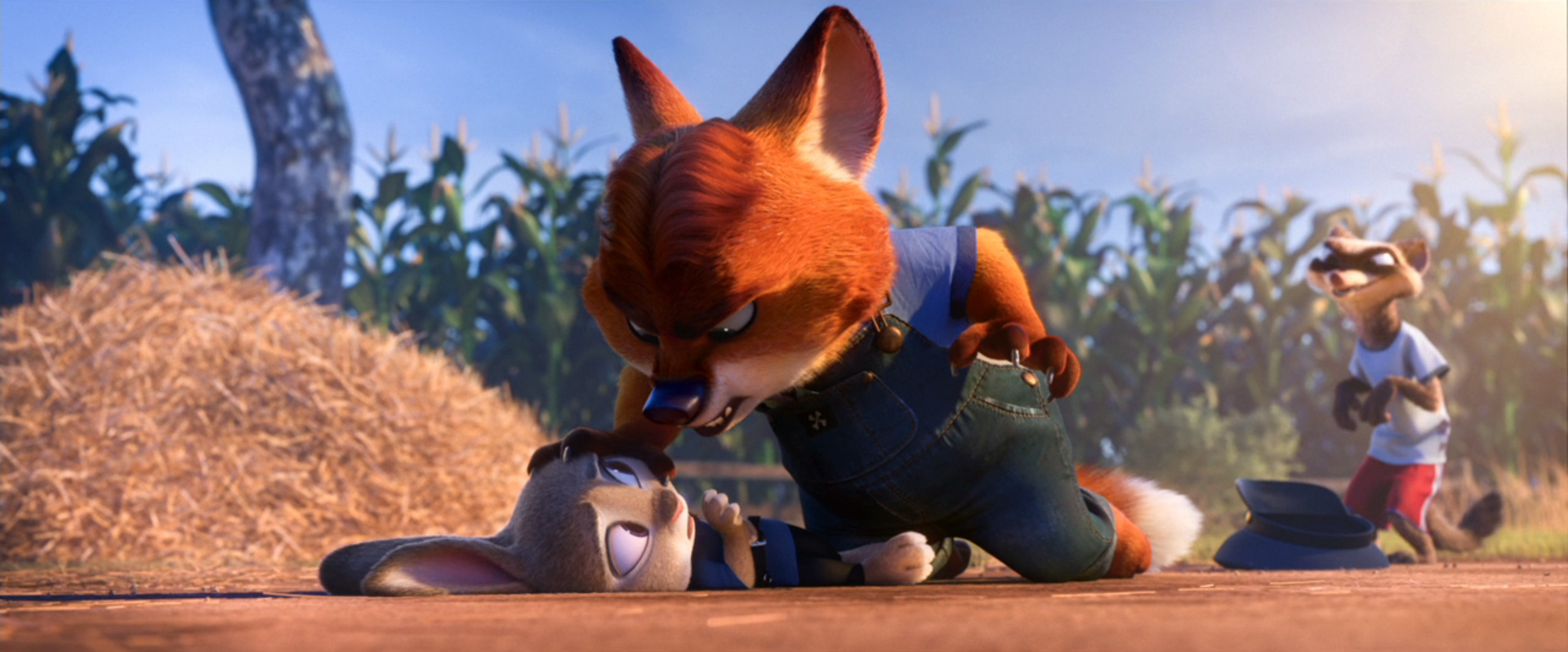
Hopps’s ambitions take her, via a strenuous intermission at a police academy, to the city of Zootropolis. She is almost immediately confronted with a range of characters who challenge her professional and sociological optimism. Already at the police academy, an ice bear drill sergeant with an urban African American accent questions her aptitude and calls her “bunny bumpkin,” “carrot face,” and “farm girl.” Similar stereotyping epithets are uttered by the same character in the Danish dub (“kanin-knoldesparker,” “grøntsagsknold,” and “landkanin”), but without any other hint that the drill sergeant is herself of the city. At her designated police station, Hopps meets Chief Bogo and the aforementioned Officer McHorn, neither of whom sees her as one of the “real cops.” Chief Bogo, a gruff and overbearing cape buffalo, speaks in an East London accent that is stereotypically suggestive of his toughness and no-nonsense leadership style. He sends Hopps out on parking duty, where she encounters a prejudiced elephant who owns an ice cream shop. The elephant’s New York City accent, which is marked by such features as th-stopping (e.g., “the” becomes “de”) and a vowel-gliding pronunciation of talking (“tawkin’”), is as strong as any that can be heard on The Sopranos (Chase 1999–2007). Hopps confronts and reprimands the elephant after he refuses to serve a fox (and predator species in general, as the viewer is led to understand).
Not one of these characters speaks with a saliently non-standard accent in the Danish version of the same film. The character that comes closest is the prejudiced elephant, who may evoke a kind of arbejderkøbenhavnsk (working-class Copenhagen dialect) by way of intonation and some subtle vowel shifts (notably, “du” becomes “då”). However, he is much less urban than his English-language equivalent, whose voice actor has revealed that he was specifically asked to perform a “stock New York” character type (FANDOM 2016, 2:05). As a result of the lack of non-standard language varieties in the Danish version of Zootopia, the urban and cosmopolitan character of Hopps’s challenges becomes much less pronounced.
Crime and Punishment
Another character with an urban accent in the English-language version of Zootopia is Duke Weaselton, a small-time criminal weasel. Hopps first encounters Weaselton when he robs a store right next to her and she chases him down. Later, we witness him trying to sell bootlegged DVDs in the street before Hopps questions him about his ties to the criminal underworld of Zootropolis. Weaselton has a New York City dialect whose features include the use of double negatives (“ain’t nothin’”) and r-dropping (“make me an offa’ [offer]”) (Fig. 2). Some commenters have noted that his criminal portrayal seems negatively stereotyping, with one suggesting that his speech “reinforces language-based stereotypes targeting AAVE [African American Vernacular English] speakers” (Soares 2017, 31). However, the character’s non-standard features do not specifically evoke Blackness. The stereotype that may be in play with Weaselton–a character whose speech is inspired by the “tough guy” roles of James Cagney (Spencer 2016, 2:20)–is better described as that of accented urbanites being crass, unsophisticated, and even criminally inclined. In his dubbed Danish voice, Weaselton expresses a certain slangy disaffectedness by his use of “panser” and repeated use of “strømer,” both of which are somewhat old-fashioned Danish argot for “police officer.” But his actual dialect is quite standard.
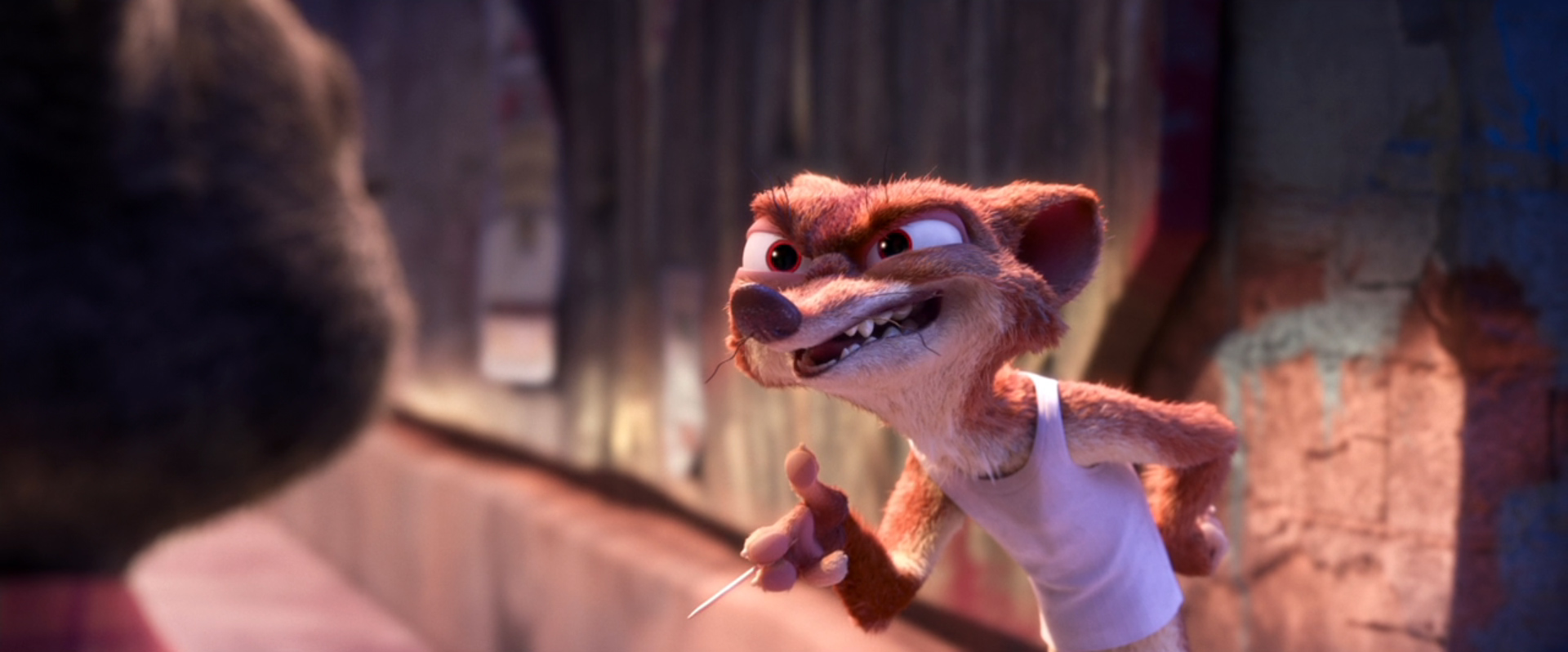
Much more evocative of Blackness than Weaselton is the sociolect of the diminutive fennec fox Finnick. Finnick is one half of a swindling duo that also includes Nick Wilde, a sly fox who antagonizes Hopps on her first workday but ends up as her trusted friend and professional partner. Wilde is not visually or linguistically marked as non-standard, but Finnick’s African American evocations include his use of zero copula (“you [you’re] a cop now, Nick”) and adverbial good (“she hustled you good!”), as well as his liking of rap music. Although there are other characters whose speech seems to associate Blackness with a non-criminal way of life–notably, Officer McHorn and the drill sergeant–it is at least initially surprising to hear such apparent stereotyping in the voice of an urban criminal. I will come back to this character, whose dubbed Danish version is again made linguistically standard.
In older Disney films, criminal and antagonistic characters often had accents that marked them as foreign (Lippi-Green 2012, chap. 7; see also Kjeldgaard-Christiansen, Boyd, and Hejná forthcoming). In Zootopia, six characters have accents that may be heard as foreign to the film’s Americanized setting (seven if one counts an uncredited snow leopard newscaster). Of these, two seem initially antagonistic and threatening. First is Mr. Big, a suit-clad Arctic shrew who heads a mafia-like family and business, and who is meant to parody Marlon Brando’s portrayal of the Sicilian-born Vito Corleone in The Godfather (Coppola 1972). In the English version of Zootopia, Mr. Big approximates Corleone’s Italian-American accent, and it is difficult to see how one could translate the relevant sociocultural and film-historical import of that accent into dubbed Danish. The Danish voice actor therefore sensibly opts only to render Corleone’s idiolect–the lock-jawed, whispery delivery that has been so strongly identified with the character–without any appreciable regional or foreign influences. That is quite enough to make the reference clear.
Then there is Mr. Manchas, a black jaguar who drives a limousine for Mr. Big. Manchas’s Latin American accent is marked by features such as vowel shifts and consonant dropping (“happened” becomes “happen”). Hopps and Wilde meet Manchas in the dark ambience of the rainforest and are immediately intimidated by his large stature and clawed face. His mauling was by an otter who suddenly and inexplicably turned extremely violent (“went savage”), and whose subsequent disappearance is the object of Hopps and Wilde’s investigation. Suddenly, Manchas himself goes savage in a horror-inspired transformation scene, forcing Hopps and Wilde into a panicked escape. Combined with his aggression, Manchas’s Latin American accent may be heard to echo certain Latino stereotypes about temperament and criminality (see Mastro and Behm-Morawitz 2005) (Fig. 3). However, as with most other characters, the dubbing strategy for Manchas in the Danish version of Zootopia is one of standardization. Manchas retains his growly voice quality and agitated prosody, but the sense of latent aggression in that voice has no specific ethnolinguistic resonance.
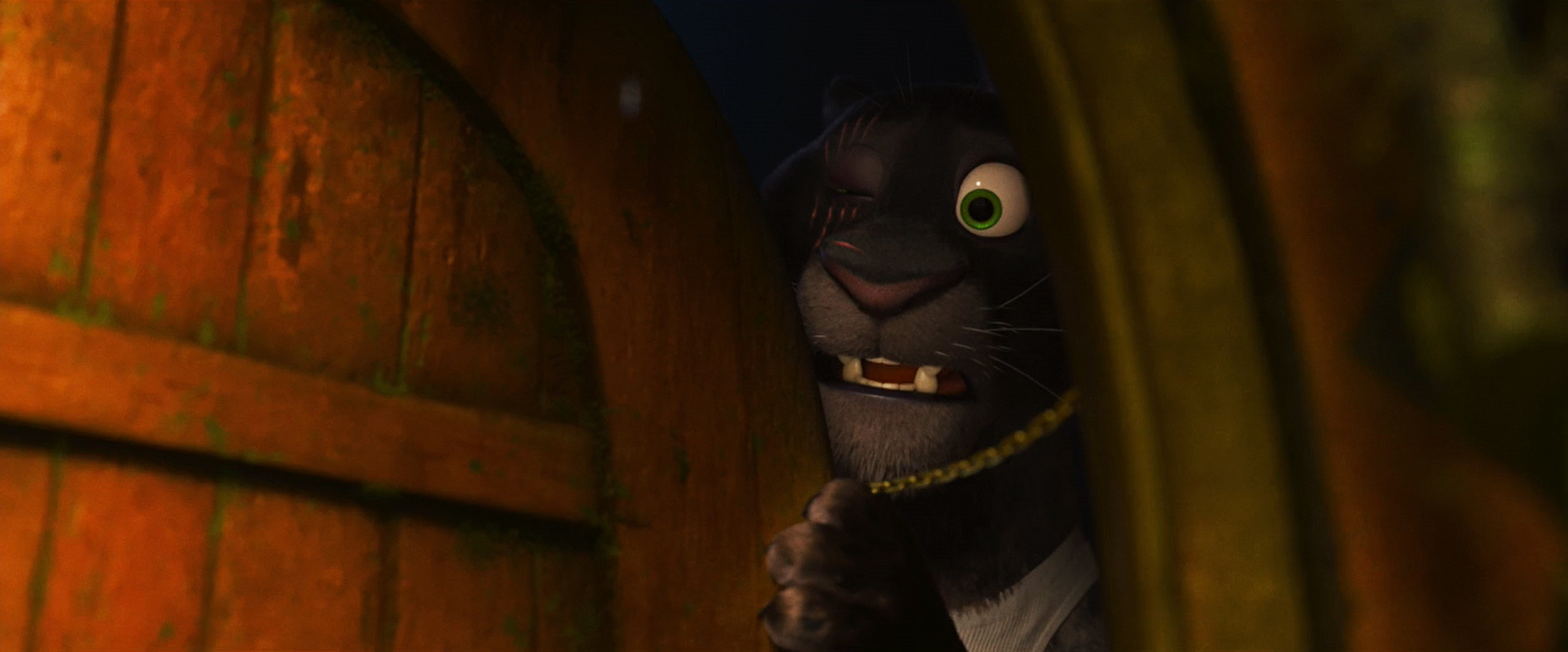
There are then saliently regional and ethnic expressions of criminality and aggressiveness in the film’s original voice performances, and it might seem good for these to be standardized out of existence. However, it is significant that narrative developments prove many of our initial impressions of the analyzed characters false or misleading, as I will soon discuss. And it is significant that the main antagonist and other truly blameworthy criminals in Zootopia present as normative and speak Standard American English. The film’s real villain is eventually revealed as Assistant Mayor Bellwether, a resentful and power-hungry sheep who wants to turn prey against predator, and who almost succeeds by having predators injected with a psychotropic drug that turns them rabidly aggressive. Other blameworthy speakers of Standard American English include Mayor Lionheart, who worked against the police investigation in order to save his job, as well as the hornless ram Doug and his two assistants, who worked with Bellwether to produce and administer the rage-inducing drug.
Stereotypes and Reality
The viewer of Zootopia should recognize a certain play with expectations here: Those characters who seem initially most frightening and antagonistic are marked as foreign or deviant, whereas the actual evildoers appear fully normative. That is not a coincidence, just as it is not a coincidence that the main villain turns out to be the proverbial wolf in sheep’s clothing (see also Kjeldgaard-Christiansen and Schmidt 2019). The point, of course, is to challenge stereotypes. But that point is linguistically muted in the Danish version of the film.
Many other social-cum-zoological stereotypes seem initially to be confirmed in Zootopia before being later subverted. Some of these take the form of innocent gags: An elephant is forgetful, and a sloth turns out to be a reckless speedster. Others are more satirically pointed: Police Chief Bogo is shown giddily bopping his shoulders to the upbeat music of a mobile phone app that superimposes his smiling visage on a bare-chested, hip-swaying dancer. In this case, the subversion targets our initial impression of the character’s traditional masculinity, which is amplified by his deep voice and East London accent in the English-language version of the film. Thus, in an interview for USA Today, co-director of Zootopia Byron Howard notes that he wanted that accent to portray this “tough boss” character (Alexander 2015).
Both satirically and thematically meaningful is the character development of Gideon Grey, who appears once more toward the end of the film when Hopps is back in Bunnyburrow. Hopps approaches Grey, who has become a pastry chef and is now working with Hopps’s parents. Grey immediately apologizes to Hopps for being “a major jerk” to her when they were growing up. He explains that his prejudiced aggression resulted from “a lot of self-doubt” that he did not know how to process. Grey’s juvenile prejudice was represented as that of a Southern redneck, but, ironically, the notion of being a prejudiced Southerner is itself a stereotype that Grey now inadvertently but pointedly challenges. He does so by losing his angry prejudice while retaining his regional dialect, thus showing that there was no necessary connection between the two in the first place (Fig. 4). He also challenges the Southern and rural stereotype of having a “small mind,” as Hopps put it in describing him, because he manages to broaden his conception of himself and of other animals. This social commentary is fully lost in the Danish version of the film, in which both the young and the adult versions of the character speak Standard Danish.
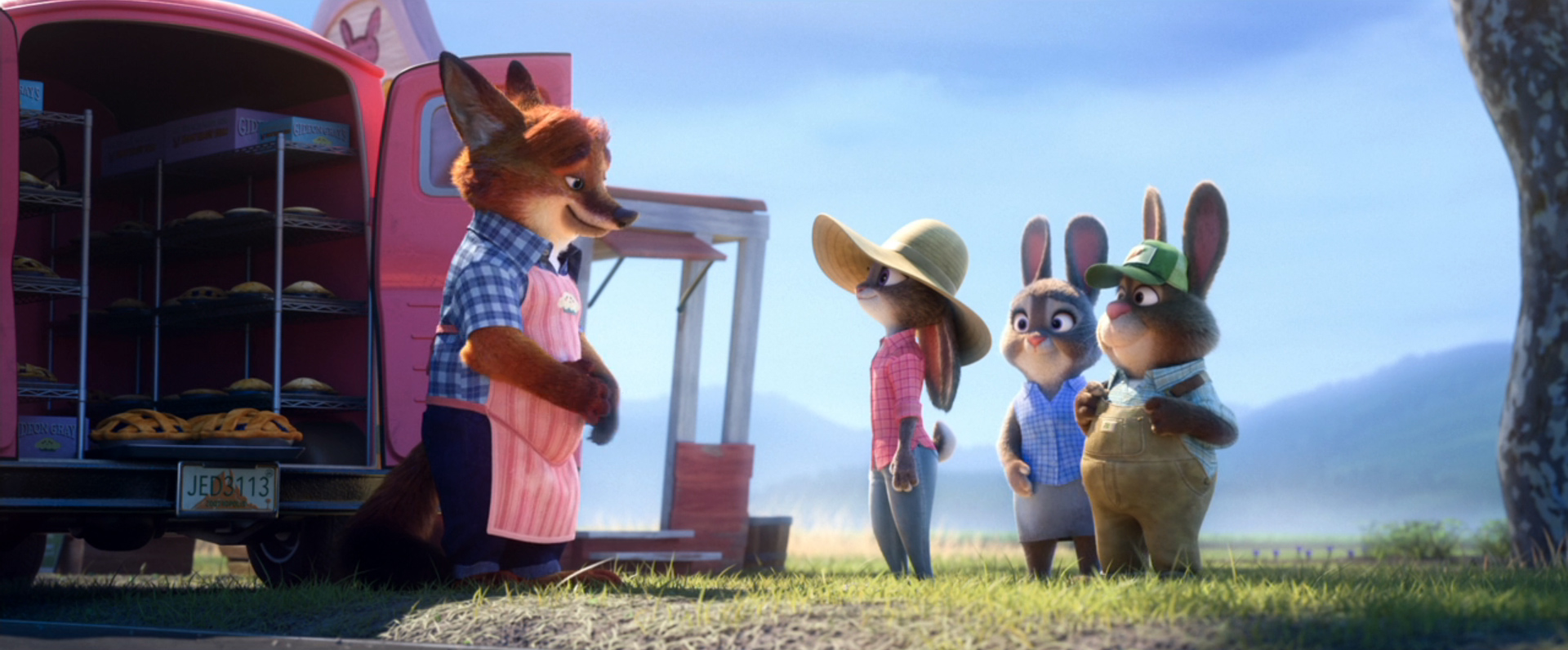
The aggressiveness of Mr. Manchas is also revealed to be unrelated to his predator (and Latin American) identity. A flashback reveals him being shot with a drug-filled dart as Hopps and Wilde were questioning him, whereupon his accented speech gives way to a deafening roar. Therefore, what might have seemed like the activation of an aggressive instinct in Manchas had nothing to do with his actual personality. (His employer, the initially threatening Mr. Big, ends up aiding Hopps and Wilde’s investigation and is therefore also redeemed.)
The criminality of Finnick is not explained away, but it is at least to some degree explained and excused. Finnick’s partner, Nick Wilde, tells Hopps of his troubled past through another flashback, which shows him being cruelly muzzled by his peers simply for being a fox. (Only the groundhog leader of this group of prey-animal bullies is heard talking, and he does so in Standard American English.) Wilde took from this experience the lesson that “if the world’s only gonna see a fox as shifty and untrustworthy, there’s no point in trying to be anything else.” Somber background music accompanies this personal confession, which is framed in a medium shot that also captures Hopps’s empathetic reaction. The viewer is made to understand that the stereotyped criminality of Finnick and other predators becomes a self-fulfilling prophecy that has no genetic or biological basis. When we last see Finnick in the film, he helps Hopps find her missing partner.
Standardization and Adaptation
One specific sign that standardization has been the strategy of choice in the Danish localization of Zootopia is the fact that it contains not a single instance of a morphosyntactic dialecticism, that is, of a non-standard way of using language that might be considered fully ungrammatical by sticklers of the standard variety. By contrast, the original, English-language version contains quite a few such dialecticisms, including adverbial good (“hustled you good”), double negation (“ain’t nothin’”), and them used as a demonstrative pronoun (“I stole them night howlers”). This and other kinds of linguistic diversity in Zootopia are narratively and thematically meaningful, as I have tried to show. Narratively, linguistic difference helps to delineate those sociocultural fault lines that Hopps must continuously navigate in solving the film’s central mystery. Thematically, it supports the film’s anti-prejudicial message because so many actual human prejudices target how different people speak (for an overview, see Kinzler 2020). But even in films that are not as concerned with bias and prejudice as Zootopia, there is a basic artistic case to be made for preserving in localization that which is intentionally expressed, whether by words or by voices, in an original production. Disney does make this a priority in the casting and instruction of international voice talent. In an interview, the former vice president of Disney Character Voices International explained that “our department was set up [to] ensure that the voices stay consistent and that they have integrity for the ancillary uses” (Morrissey 2015).
Of course, that is easier said than done when it comes to accents and dialects. Some American English language varieties are suggestive of backgrounds and traits that may not be adequately expressed by any Danish-language substitute. For example, while in Zootopia a West Jutland dialect could evoke the young Gideon Grey’s small-minded provincialism, it does not echo the historical racism that is a subtler part of his portrayal. One could therefore debate the soundness of this adaptation (which I would defend because Grey’s provincialism is so thematically resonant). Other accents and dialects seem more easily substitutable, such as New York City English by a generic Copenhagen dialect: Both are associated with urbanity as well as with competence and disagreeableness (Kristiansen 2001; Preston 1996). Finnick’s use of African American Vernacular English (Fig. 5) could perhaps have been rendered by an accent of gadedansk (“street Danish”)–commonly spoken among multiethnic urban communities–with which it shares many sociodemographic connotations. The point of such adaptations would be not only to secure relevantly “consistent” portrayals of individual characters for Danish audiences, but also to capture something of the original film’s overall sociolinguistic diversity, which plays strongly and repeatedly into its message.
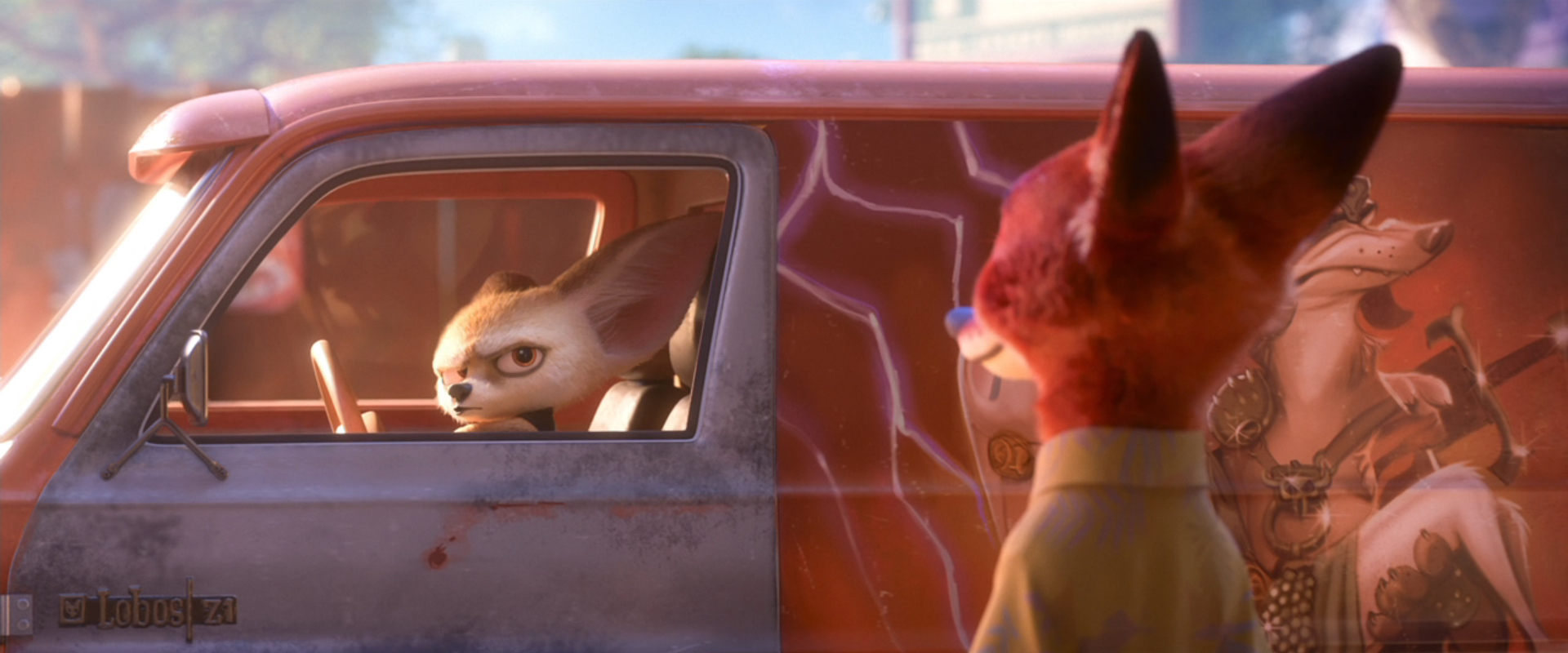
Of course, even if these and other voices were so adapted, it is not a given that younger Danish audiences would register the relevant evocations. But a similar point could be made about the original, English-language version of the film, which contains different layers of meaning intended to be grasped and appreciated by audiences of different ages. That is often the case in Disney’s major animated films (Wasko 2001), and it is surely intended also to be the case in their localized versions.
Why then standardization instead of adaptation? One argument is that adaptation might redirect such harmful linguistic stereotyping as exists in an original production to a different language community (e.g., Dore 2020). It does indeed seem good to abandon negative stereotypes, but that could hardly be a reason to adopt standardization as a general or default dubbing strategy. It could only be a reason for standardizing specific offensive portrayals.
Many other considerations in favor of linguistic standardization boil down to something like the following argument: If a linguistic adaptation does not capture all the relevant associations of the original non-standard language variety, then any such disconnect can be readily pointed to as a mistranslation (e.g., Chaume 2014, 137). Standardization may then be seen as a safer bet because it does what absolutely needs to be done–render the speech of the film’s characters comprehensible to the target audience–without making assumptions and taking risks in so domesticating a foreign culture. I think that this argument is worth taking seriously, and that it may well justify some significant measure of standardization in many dubbing practices. However, I also hope to have shown how much may be lost in this mode of translation when linguistic diversity contributes broadly to the themes and narration of a film.

Facts
Zootopia 2 is scheduled for release in 2025.
Films and Series
- The Godfather (1972), dir. Francis Ford Coppola.
- The Sopranos (1999–2007), dir. David Chase.
- Zootopia (2016), dir. Byron Howard and Rich Moore.
Literature
- Alexander, Bryan. 2015. “Sneak Peek: Idris Elba Goes into Zootopia Beast Mode.” USA Today, October 25, 2015.
- Chaume, Frederic. 2014. Audiovisual Translation: Dubbing. London: Routledge.
- Chiaro, Delia. 2008. “Where Have All the Varieties Gone: The Vicious Circle of the Disappearance Act in Screen Translations.” In Dialect for All Seasons: Cultural Diversity as Tool and Directive for Dialect Researchers and Translators, edited by Irmeli Helin, 9–25. Münster: Nodus Publikationen.
- DiMaggio, John. 2016. “Zootopia Interview – John DiMaggio and Maurice LaMarche.” Interview by FANDOM. June 10, 2016. Video, 7:11.
- Dore, Margherita. 2020. “Revoicing Otherness and Stereotypes via Dialects and Accents in Disney’s Zootopia and Its Italian Dubbed Version.” In “New Perspectives in Dialects and Multimedia IV,” special issue, InTRAlinea.
- Goris, Olivier. 1993. “The Question of French Dubbing: Towards a Frame for Systematic Investigation.” Target 5 (2): 169–90.
- Hayes, Lydia, and Alejandro Bolaños-García-Escribano. 2022. “(Main)streaming English Dubs: A Snapshot of Netflix’s Playbook on Strategies for English Dubbing.” Journal of Audiovisual Translation 5 (2): 213–33.
- Hodson, Jane. 2014. Dialect in Film and Literature. London: Palgrave MacMillan.
- Kinzler, Katherine D. 2020. How You Say It: Why You Talk the Way You Do and What It Says About You. Boston, MA: Houghton Mifflin Harcourt.
- Kjeldgaard-Christiansen, Jens, and Sarah H. Schmidt. 2019. “Disney’s Shifting Visions of Villainy from the 1990s to the 2010s: A Biocultural Analysis.” Evolutionary Studies in Imaginative Culture 3 (2): 1–16.
- Kjeldgaard-Christiansen, Jens, Zac Boyd, and Míša Hejná. Forthcoming. “Teaching Children to Discriminate? A Quantitative Study of Linguistic Representation in Disney’s ‘Revival Era’ Animated Films.” MedieKultur: Journal of Media and Communication Research.
- Kristiansen, Tore. 2001. “Two Standards: One for the Media and One for the School.” Language Awareness 10 (1): 9–24.
- Lippi-Green, Rosina. 2012. English with an Accent: Language, Ideology and Discrimination in the United States. 2nd ed. New York: Routledge.
- Mastro, Dana E., and Elizabeth Behm-Morawitz. 2005. “Latino Representation on Primetime Television.” Journalism & Mass Communication Quarterly 82 (1): 110–30.
- Morrissey, Thomas. 2015. “Meet Rick Dempsey.” DisneyExaminer, March 2, 2015.
- Preston, Dennis R. 1996. “Where the Worst English Is Spoken.” In Focus on the USA, edited by Edgar W. Schneider, 297–360. Amsterdam: John Benjamins Publishing Company.
- Schneider, Edgar W. 2005. “The English Dialect Heritage of the Southern United States.” In Legacies of Colonial English: Studies in Transported Dialects, edited by Raymond Hickey, 262–309. New York: Cambridge University Press.
- Soares, Telma O. 2017. Animated Films and Linguistic Stereotypes: A Critical Discourse Analysis of Accent Use in Disney Animated Films. MA thesis, Bridgewater State University.
- Spencer, Clark. 2016. “Zootopia Producer behind the Scenes Interview – Clark Spencer.” Interview by Flicks and the City. Feb. 17, 2016. Video, 5:22.
- Ulrych, Margherita. 2000. “Domestication and Foreignization in Film Translation.” In Tradurre Il Cinema, edited by Christopher Taylor, 127–44. Trieste: University of Trieste.
- Wasko, Janet. 2001. “Challenging Disney Myths.” Journal of Communication Inquiry 25 (3): 237–57.
Acknowledgments
- I would like to thank Mathias Clasen, Míša Hejná, Nicolai Pharao, Mette Hjortshøj Sørensen, and Sten Vikner for very helpful discussion and feedback on this project.
